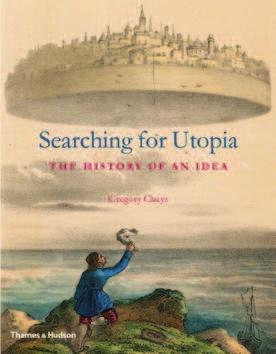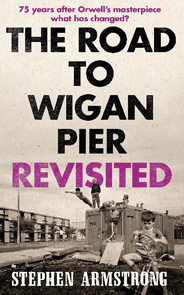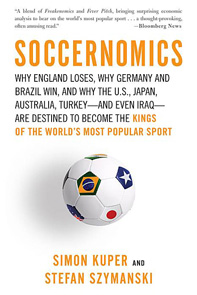Book Reviews: ‘Searching for Utopia’, ‘The Road to Wigan Pier Revisited’, ‘Soccernomics’
Utopia
Searching for Utopia. The History of an Idea, by Gregory Claeys. Thames and Hudson, London, 2011. £24.95.
 Gregory Claeys has provided an extensive and lavishly illustrated survey of utopian thought. In its early chapters it ranges from ancient origin myths through to the classic texts of Thomas More. It then moves on to look at the modern era; it includes visions of model communities by Robert Owen and others, and comes right up to date with modern science fiction and dystopian views of the future. Claeys’ definition of utopia is broad and covers the exploration in a plausible way of “the space between the possible and the impossible”. The role of utopia, for Claeys, is crucial to the process of social change as it transcends the distance between this world and the ideal described. Utopia can be used as a literary means of closing the gap in our imaginations between where we are and where we want to go.
Gregory Claeys has provided an extensive and lavishly illustrated survey of utopian thought. In its early chapters it ranges from ancient origin myths through to the classic texts of Thomas More. It then moves on to look at the modern era; it includes visions of model communities by Robert Owen and others, and comes right up to date with modern science fiction and dystopian views of the future. Claeys’ definition of utopia is broad and covers the exploration in a plausible way of “the space between the possible and the impossible”. The role of utopia, for Claeys, is crucial to the process of social change as it transcends the distance between this world and the ideal described. Utopia can be used as a literary means of closing the gap in our imaginations between where we are and where we want to go.
Claeys, however, goes much further in his claims for utopia, without which, he argues: “humanity would never have struggled onwards towards betterment. It is a pole-star, a guide, a reference point on a common map of an eternal quest for the improvement of the human condition” (p.15). In a rather bleak concluding chapter the future of humanity is proffered as hinging on the success of a “realistic utopianism”, which is liberal, forward-looking, scientific and tolerant.
For Claeys it is the idea, the vision of society depicted, which drives change. There is no explanation offered as to why ancient societies looked back to religious or mythical origin-myths or why utopia became more and more anchored in this world. Nor is there an exploration of why some utopias fail to connect with wider society whilst others add fuel to rapid social and political change. Claeys points out that ancient and medieval utopias assumed scarcity and hierarchy but that this changed in the modern era as utopias came to stress the possibility of abundance and equality: “The decline in religious belief accompanying modernity has …displaced the search for equality in the afterlife by an enhanced desire to achieve it in this life” (p.13). He does not, however, discuss how these changes in ideas about human potential relate to the material world in which the ideas emerge.
The treatment of Marx suffers for the same reasons. Claeys’approach results in a skewed perspective as it searches for Marx’s ideas of what a socialist future would look like. There is an attempt to see Marx “as the greatest of all modern utopian writers”because he projected “the utopian scheme”of community of property to a large audience. It is argued that in the Communist Manifesto Marx (and Engels) proposed “a highly centralized system of economic administration in which credit, transportation and the method of production generally were to be managed by the state” (p.145). This is taking some proposals in the Communist Manifesto and using them to make conclusions about Marx’s thought that are grossly distorted. In 1848 Marx and Engels envisaged state control of industry as a means of developing further the means of production to allow the possibility of communism –a proposal Marx did not think necessary later in his life as by that time the means of production had vastly expanded.
In fact, Marx was loath to lay down ideas of a future socialist society beyond its broad character of bringing class exploitation to an end (of which the end of money and the state would be consequences). His contribution to socialist thought was not to propose ideas of what socialism might look like but to further understanding of the social and economic processes that created its possibility and necessity.
Claeys’ book is a wide-ranging primer on the history of utopian thought. For the socialist reader it highlights the still useful distinction made by Engels between utopian socialism and scientific socialism. The former seeks to implement an idealised plan of society which would spread by force of example. The latter seeks to develop an understanding of the underlying material forces operating in society, now and in the past. In so doing it aims to build a consciousness of class exploitation and the need for a revolutionary transition to socialism based on working class social and political consciousness of this economic exploitation. The idea of socialism as a plan of an ideal society has little relevance to scientific socialism because the future society emerges from class conscious revolution moulded in the process of working class self-emancipation and not derived from a prior blueprint.
Csk
************************************************************
Nowt to look forward to
The Road to Wigan Pier Revisited, by Stephen Armstrong. Constable. £11.99.
 In 1936 George Orwell travelled to Wigan and wrote a classic account of the extent and effects of poverty. Now Stephen Armstrong has gone not just to Wigan but also to other towns in the north of England to report his findings.
In 1936 George Orwell travelled to Wigan and wrote a classic account of the extent and effects of poverty. Now Stephen Armstrong has gone not just to Wigan but also to other towns in the north of England to report his findings.
There are many similarities between the thirties and now: a recession, high unemployment and cuts in government spending, for instance. Above all, there is destitution, as many people are barely able to survive on what little they earn or the pittance they receive from the state. It is the personal accounts Armstrong provides that bring this home far more than any statistics could do.
One nineteen-year-old woman in Manchester was pregnant but she overslept and missed her first scan. As she had no proof she was pregnant, the Job Centre sanctioned her for being late for an interview: she was taken off Jobseeker’s Allowance and had to make do with hardship payments of £28 a week. Job Centre staff are given a target of referring three people a week for sanctioning (their jobs supposedly consist of helping people into employment).
Another woman was made redundant, and now she cannot afford to heat her house in winter. She cuts Brillo pads in half before using them, has stopped buying butter since it went up 5p and uses her old clothes as cleaning cloths. One twelve-year-old sometimes eats only a bowl of cereal a day. He has never been outside Wigan. Another woman gets about £8 a day in benefits and is reduced to sleeping on her daughter’s sofa. She says, “It’s horrible, there’s nowt to look forward to, there’s nowt to fetch kids into this world. I’ve worked all my life and I’ve got nothing to show.”
Most of the poor are not on benefits, however, but are employed. A particularly nasty development is zero-hour contracts, which do not actually guarantee paid work during slack periods. One man interviewed had a four-hour contract at Argos in Warrington, which made him ineligible for unemployment benefit. Things were OK when he worked 36 hours a week, but during a period of heavy snow there were few shoppers and most staff were sent home with four hours pay at minimum wage: £28. These and many others are part of the ‘precariat’ (a blend of precarious and proletariat).
As Armstrong says, ‘the poor make a lot of people very, very rich’. If you pay for gas or electricity using a prepayment meter or cards, you pay a much higher rate than those who get a regular bill. Payday loan companies and doorstep lenders such as Provident Financial exploit this ‘non-standard credit market’ and do very nicely out of it (Provident made pre-tax profits of £62 million in the first six months of 2011). Rent-to-buy companies like BrightHouse sell TVs and other goods via weekly payments which can add up to well over twice the straightforward purchase price. They have vicious late-payment charges and are not above shouting to the whole street that you owe them money. A New York hedge fund has a majority stake in the company.
Unfortunately, Armstrong spends too much time criticising MPs for fiddling their expenses, and does not look into the real reasons for the poverty he depicts, class ownership and the profit motive.
PB
************************************************************
A Football Focus
Soccernomics, by Simon Kuper and Stefan Szymanski. HarperSport. 2012. £8.99
 A couple of years ago Kuper (who is a writer on the FT Weekend Magazine) and Szymanski (a sports economist) wrote an eye-catching book about soccer called Why England Lose. This is the expanded and updated version under a new title, and it proves a thought-provoking read. It looks at the economics of individual football clubs and the soccer industry as a whole and goes on to use statistical approaches to deconstruct and explain fan loyalty, racism in football, and why some clubs and countries appear to gain a competitive advantage over others.
A couple of years ago Kuper (who is a writer on the FT Weekend Magazine) and Szymanski (a sports economist) wrote an eye-catching book about soccer called Why England Lose. This is the expanded and updated version under a new title, and it proves a thought-provoking read. It looks at the economics of individual football clubs and the soccer industry as a whole and goes on to use statistical approaches to deconstruct and explain fan loyalty, racism in football, and why some clubs and countries appear to gain a competitive advantage over others.
One of the book’s key findings is that, contrary to the assumptions of many, clubs that pay large transfer fees don’t necessarily buy success. Indeed, in most cases they only succeed in racking up debts. (Arguably the one recent exception to this has been Manchester City.) Based on an analysis of Premier League and Championship clubs in England over ten years, the authors argue: “It seems that high wages help a club much more than do speculative transfers . . . [over time] the size of their wage bills explained a massive 92 per cent of variation in their league positions”.
Also of interest is the chapter, ‘The Curse of Poverty: Why Poor Countries are Poor at Sport’. The authors construct tables of countries’sporting prowess (not just in football, but in other major sports where there is a genuine global competition, and in athletics too). The key finding is that there is a close correlation between a country’s sporting performance and its position on the UN human development index, which measures life expectancy, literacy, education and living standards.
The authors also analyse the changing nature of modern football fandom and find that increasing numbers of supporters –especially those of the larger clubs –are shopping in the postmodern supermarket. They turn their attention to whether football fanaticism means suicide rates increase when teams get knocked out of major tournaments. The ‘bread and circuses’argument of Marxists seems to gain some justification because their research demonstrates that perceptions of social cohesion within capitalism increase during major sporting tournaments, especially where the national team is participating, even leading to a noticeable fall in suicide rates. People’s underlying condition or situation in society hasn’t changed, but for a few brief weeks they feel less isolated from the human beings around them. But then, of course, the usual sense of alienation and ennui kicks in again.
One of the author’s key arguments is that just as capitalism more generally relies on knowledge networks and ‘social production’, so do sports like football. Indeed, they contend that the greatest concentration of soccer clubs in advanced industrial capitalism is in Western Europe and it is here that the greatest advances in both fitness and tactics have been developed. This includes the notion –seen most clearly in the Champions League –that the best way to win games is ‘fast passing’based on split-second touch football, rather than dribbling or the long-ball.
There is also a fascinating chapter on the nature of the European teams that win big tournaments, with many of them for a long period in Europe being from smaller provincial cities (Nottingham Forest, Borussia, Monchengladbach, etc). While the authors do seem to exaggerate to make a point on occasion, they go a long way to explain why clubs from large metropolitan areas and capital cities (which often tended to underperform in the past) are now increasingly dominating European competitions. And their predictive powers based on this analysis appear to be good –when this book came out they argued that Chelsea or Arsenal would soon be the first London club ever to win the Champions League. It must have happened before the ink was dry.
DAP
